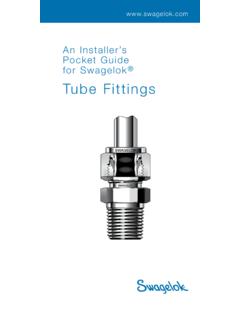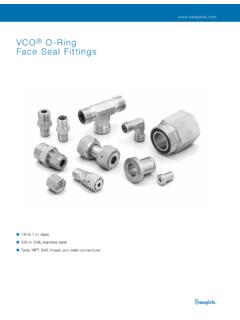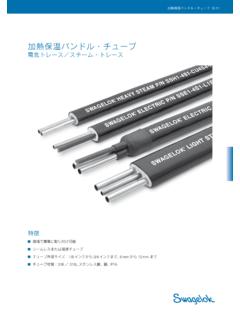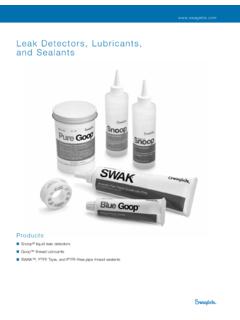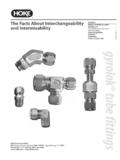Transcription of Hand Tube Bender Manual (MS-13-43;rev 5;en …
1 hand tube Bender .. 4 Tubing Data .. 4 Tubing Installation .. 6 Product Information .. 7 Vise Clamp Block .. 8 Bend Layout .. 9 Using the Bender .. 12 Making Bends .. 15 Reverse Bends .. 18 Springback .. 19 Determining Changes in Plane and Direction .. 20 Adjustment (Gain) Calculations .. 21 Troubleshooting .. 24 Replacement Parts .. 264 IntroductionSwagelok hand tube benders provide consistent, high quality bends in tubing made from most materials used with swagelok tube fittings .Read this Manual before using the hand tube Bender .Tubing Data The swagelok hand tube Bender bends 1/8, 1/4, 5/16, 3/8, and 1/2 in.
2 , and 3, 6, 8, 10, and 12 mm outside diameter tubing in a variety of wall thicknesses . Tubing should be free of scratches and suitable for bending . Suggested Tubing Ordering InformationFractional TubingHigh quality, soft annealed, seamless carbon steel hydraulic tubing ASTM A179 or equivalent . Hardness 72 HRB (130 HV) or less .Fully annealed, high quality (Type 304, 316 etc .) (seamless or welded and drawn) stainless steel hydraulic tubing ASTM A269 or A213, or equivalent . Hardness 90 HRB (200 HV or less) .Tube ODApprox Bend RadiusCarbon Steel Wall Thickness Min/MaxStainless Steel Wall Thickness Min/MaxDimensions, .028/0 .0351/49/160 .028/0 .0653/40.
3 028/0 .0655/1615/160 .035/0 .0653/815/160 .035/0 .0650 .035/0 .0831/21 1/20 .035/0 .0835 Metric TubingHigh quality, soft annealed, carbon steel hydraulic tubing DIN2391 or equivalent . Hardness 130 HV (72 HRB) or less .Fully annealed, high quality (Type 304, 316 etc .) stainless steel tubing EN ISO 1127 or equivalent . Hardness 200 HV (90 HRB) or less .Tube ODApprox Bend RadiusCarbon Steel Wall Thickness Min/MaxStainless Steel Wall Thickness Min/MaxDimensions, mm3150 .8/1 .00 . 8/0 .86150 .8/1 .58241 .0/1 .510241 .0/1 .51 .0/2 .012381 .0/2 .21 .0/2 .06 Tubing InstallationProperly selected tubing, combined with quality swagelok tube fittings, can provide leak tight systems.
4 When installing fittings near tube bends, there must be a sufficient length of straight tubing to allow the tube to be bottomed in the swagelok tube fitting:LTRM etric, mmTTube ODRBend RadiusL315196152182423102425123831 Fractional, in .TTube ODRBend RadiusL1/89/1623/321/49/1613/163/45/1615 /167/83/815/1615/161/21 1/21 3/16T Tube OD L Required straight tube length (see table) (corresponds to straight tube length mark on hand Bender .)R Radius of tubing bend7 Product InformationClevisLinkRoll diesBender dieVise clamp blockName plateTube latchRoll supportLong handleShort handleName plateStraight tube length mark8 Vise Clamp BlockThe swagelok hand tube Bender features a vise clamp block which allows the Bender to be clamped in a vise.
5 This feature is helpful when bending tube of a hard material or heavy wall thickness, or long pieces of tubing that need to be supported .9 Bend LayoutThis Bender can be used to form single, offset, and other bends . This section contains information for measuring and marking the tube prior to bending . Note: Make all marks 360 around the tube .The Measure-Bend Method 1 . Estimate the overall length of tubing required by adding the length of all the sections together . 2 . Place a reference mark at the end of the tube from which you are beginning the measurement . 3 . Measure from the reference mark and make a bend mark on the tube at a distance equal to the desired bend length.
6 This mark indicates the vertex of the bend . 4 . See Using the Bender , page 12, to bend the tube . 5 . For additional bends, use the vertex of the previous bend as the reference mark, repeat steps 3 and 4 for the next bend . (The vertex is where the center lines of the two legs of the angle intersect .) An example appears on the next page .10 Example of the measure bend method: A 90 bend 4 inches from the reference mark followed by a 45 bend with 4 inches between bends . 1 . Place a reference mark at the end of the tube from which you are beginning the measurements . 2 . Measure 4 in . from the reference mark and make a bend mark to indicate the first desired bend length.
7 3 . Bend the tube 90 as described in Using the Bender , page 12 . 4 . Make a second bend mark 4 in . from the vertex of the 90 bend, away from the reference mark . 5 . Place a directional mark over the bend mark to indicate the outside, or heel, of the 45 bend . This will help ensure the bend is made in the intended direction . 6 . Bend the tube 45 as described in Using the Bender , page 12 . Directional markSecond 90 in .Vertex45 VertexReference mark4 in .11 Offset Bend FormulaThe purpose of an offset bend is to change the center line of the run, typically to avoid an obstruction . To determine the length of offset, select the offset angle (E).
8 Then, multiply the offset dimension (O) by the offset bend allowance (A) . L = O AUse the offset calculation as the distance between the bend marks described in Bend Layout .Offset Bend Angle (E) Offset Bend Allowance (A)22 1/2 2 .61330 2 .00045 1 .41460 1 .15 4 ExampleOffset bend angle (E) 45 Offset dimension (O) 6 .75 in .6 .75 1 .414 = 9 .55 in ., or approximately 9 9/16 in .CCOLECC6 .75 in .9 9/16 in .45 12 3 . Place the tube in the groove of the Bender die with the reference mark to the left of the tube latch . 4 . Close the tube latch over the tube just enough to hold the tube in place . This restricts movement of the tube during initial positioning but still allows for additional alignment.
9 Short handleBender dieTube latchUsing the Bender 1 . Swing the short handle up so it is above the Bender die . 2 . Open the tube latch . Bender dieReference markTube latch13 5 . Carefully lower the short handle until the roll dies rest gently on the tube while keeping the link straight and parallel to the long handle . Note: Premature bending may occur if the link is not straight and parallel to the long handle . 6 . Align the zero on the roll support with the zero on the name plate .Short handleLong handleReference markLinkRoll dies (one is hidden by link)Shown aligned for a 90 bend. Note: View shown is from the back of the Bender .
10 Name plateRoll supportReference markBend mark14 8 . Push the tube latch firmly over the tube to secure the tube in the Bender die . Note: Excessive pressure on the tube latch may damage soft tubing . 7 . Align the bend mark with the mark on the roll support that corresponds to the bend angle .Tube latchBender die Note: View the marks on the hand tube Bender as a 0 to 90 scale when bending other angles .15 30 60 75 90 45 15 2 . After completing the bend, swing the short handle up and away from the tube . 1 . Slowly push the short handle down until the 0 on the roll support reaches the desired degree mark on the name plate . Note: Be aware of springback, described on page 19.
